Estimation of the Wind Energy Potential in Various North Algerian Regions
Abstract
:1. Introduction
2. Mathematical Tools
2.1. Modeling of the Wind Speed Frequency
2.2. Determination of Weibull Parameters
- (i)
- The least mean squares method;
- (ii)
- The maximum likelihood method;
- (iii)
- The process of standard deviation.
2.3. Estimation of the Annual Wind Potential
3. Findings and Analysis
3.1. Distribution of Wind Speed
3.2. Determination of the Recovered Power by Year
3.3. Wind Turbine Selection
4. Conclusions
- -
- At a height of 10 m, the yearly mean wind velocity ranges from 2.48 to 5.60 m/s. The chosen locations have a lower wind character, i.e., vmean = 3.13 m/s.
- -
- At the study stations, the annual values of Weibull parameters (k and c) ranged from 1.61 to 2.43 and 3.32 to 6.20 m/s, respectively.
- -
- The mean wind power density varied from 11.48 at Chlef to 238.43 W/m2 at Tiaret.
- -
- The monthly wind recoverable potential varied from 16.64 to 138 W/m2.
Author Contributions
Funding
Institutional Review Board Statement
Informed Consent Statement
Data Availability Statement
Acknowledgments
Conflicts of Interest
References
- Abderrahim, A.; Boudia, M.M.; Ghellai, N.; Menni, Y.; Ameur, H. Determination of the wind potential in some regions of Algeria. Iran. (Iran.) J. Energy Environ. 2020, 11, 193–197. [Google Scholar]
- Barrows, S.E.; Homer, J.S.; Orrell, A.C. Valuing wind as a distributed energy resource: A literature review. Renew. Sustain. Energy Rev. 2021, 152, 111678. [Google Scholar] [CrossRef]
- Peng, X.; Liu, Z.; Jiang, D. A review of multiphase energy conversion in wind power generation. Renew. Sustain. Energy Rev. 2021, 147, 111172. [Google Scholar] [CrossRef]
- Barra, P.H.A.; de Carvalho, W.C.; Menezes, T.S.; Fernandes, R.A.S.; Coury, D.V. A review on wind power smoothing using high-power energy storage systems. Renew. Sustain. Energy Rev. 2021, 137, 110455. [Google Scholar] [CrossRef]
- de Siqueira, L.M.S.; Peng, W. Control strategy to smooth wind power output using battery energy storage system: A review. J. Energy Storage 2021, 35, 102252. [Google Scholar] [CrossRef]
- Chidambaram, P.K.; Thamilarasan, K.; Kumar, J.B.; Mary, L.A. A review on turbines in power production using wind and hydro energy. Mater. Today Proc. 2021. [Google Scholar] [CrossRef]
- Hevia-Koch, P.; Ladenburg, J. Where should wind energy be located? A review of preferences and visualisation approaches for wind turbine locations. Energy Res. Soc. Sci. 2019, 53, 23–33. [Google Scholar] [CrossRef]
- Igwemezie, V.; Mehmanparast, A.; Kolios, A. Current trend in offshore wind energy sector and material requirements for fatigue resistance improvement in large wind turbine support structures—A review. Renew. Sustain. Energy Rev. 2019, 101, 181–196. [Google Scholar] [CrossRef] [Green Version]
- Zhu, W.J.; Shen, W.Z.; Barlas, E.; Bertagnolio, F.; Sørensen, J.N. Wind turbine noise generation and propagation modeling at DTU Wind Energy: A review. Renew. Sustain. Energy Rev. 2018, 88, 133–150. [Google Scholar] [CrossRef]
- Swenson, L.; Gao, L.; Hong, J.; Shen, L. An efficacious model for predicting icing-induced energy loss for wind turbines. Appl. Energy 2022, 305, 117809. [Google Scholar] [CrossRef]
- Singh, S.; Fozdar, M.; Malik, H.; Fernandez Moreno, M.D.V.; Garcia Marquez, F.P. Influence of wind power on modeling of bidding strategy in promising power market with a modified gravitational search algorithm. Appl. Sci. 2021, 11, 4438. [Google Scholar] [CrossRef]
- Oh, E. Reinforcement-learning-based virtual energy storage system operation strategy for wind power forecast uncertainty management. Appl. Sci. 2020, 10, 6420. [Google Scholar] [CrossRef]
- Wang, Y.; Zou, R.; Liu, F.; Zhang, L.; Liu, Q. A review of wind speed and wind power forecasting with deep neural networks. Appl. Energy 2021, 304, 117766. [Google Scholar] [CrossRef]
- Li, L.L.; Shen, Q.; Tseng, M.L.; Luo, S. Power system hybrid dynamic economic emission dispatch with wind energy based on improved sailfish algorithm. J. Clean. Prod. 2021, 316, 128318. [Google Scholar] [CrossRef]
- Celik, A.N. Energy output estimation for small-scale wind power generators using Weibull-representative wind data. J. Wind Eng. Ind. Aerodyn. 2003, 91, 693–707. [Google Scholar] [CrossRef]
- Balasubramanian, K.; Thanikanti, S.B.; Subramaniam, U.; Sudhakar, N.; Sichilalu, S. A novel review on optimization techniques used in wind farm modelling. Renew. Energy Focus 2020, 35, 84–96. [Google Scholar] [CrossRef]
- Tao, S.; Xu, Q.; Feijóo, A.; Zheng, G.; Zhou, J. Nonuniform wind farm layout optimization: A state-of-the-art review. Energy 2020, 209, 118339. [Google Scholar] [CrossRef]
- Kheirabadi, A.C.; Nagamune, R. A quantitative review of wind farm control with the objective of wind farm power maximization. J. Wind Eng. Ind. Aerodyn. 2019, 192, 45–73. [Google Scholar] [CrossRef]
- Rippel, D.; Jathe, N.; Becker, M.; Lütjen, M.; Szczerbicka, H.; Freitag, M. A Review on the planning problem for the installation of offshore wind farms. IFAC-Pap. Online 2019, 52, 1337–1342. [Google Scholar] [CrossRef]
- Shakoor, R.; Hassan, M.Y.; Raheem, A.; Wu, Y.K. Wake effect modeling: A review of wind farm layout optimization using Jensen׳ s model. Renew. Sustain. Energy Rev. 2016, 58, 1048–1059. [Google Scholar] [CrossRef]
- Benmedjahed, M.; Maouedj, R.; Mouhadjer, S.; Menni, Y.; Ameur, H.; Dahbi, A.; Saba, D.; Touahri, T. Analysis of the wind resources in Saharan Atlas of Algeria: Adrar region as a case study. Iran. (Iran.) J. Energy Environ. 2021, 12, 155–160. [Google Scholar]
- Mederreg, D.; Salmi, M.; Rachid, M.; Ahmad, H.; Lorenzini, G.; Menni, Y.; Ameur, H. Assessment of the resources of wind energy in various regions of Algeria. Int. J. Sustain. Dev. Plan. 2021, 16, 641–650. [Google Scholar] [CrossRef]
- Abderrahim, A.; Ghellai, N.; Bouzid, Z.; Menni, Y. Wind energy resource assessment in south western of Algeria. Math. Model. Eng. Probl. 2019, 6, 157–162. [Google Scholar] [CrossRef]
- Merzouk, N.K. Algeria Wind Map-Preliminary Results. Renew. Energy Rev. (Rev. Des Energ. Renouvelable) Valoris. 1999, 2, 209–214. [Google Scholar]
- Ettoumi, F.Y. Renewable Energy Resources in Algeria. Ph.D. Thesis, University of Science and Technology Houari Boumediene, Bab Ezzouar, Algeria, 2002. [Google Scholar]
- Boudia, S.M.; Benmansour, A.; Hellal, M.A.T. Wind resource assessment in Algeria. Sustain. Cities Soc. 2016, 22, 171–183. [Google Scholar] [CrossRef]
- Oumalli, A.; Baccari, N. Wind Energy Development in Tunisia. In Proceedings of the Wind Energy and Development Dialogue, Berlin, Germany, 8–12 October 2007. [Google Scholar]
- Taya, B.; Chaguer, L. Energie éolienne au Maroc. In Proceedings of the Congrès International FIER, Tetouan, Marocco, 8–10 May 2002. [Google Scholar]
- Chitour, C.E. Global energy balance and forecast for 2030: The place of renewable energies. In Proceedings of the 1st Mediterranean Seminar on Wind Energy, Bou-Ismail, Tipaza, Algeria, 11–12 April 2010. [Google Scholar]
- Ahmad, J.; Imran, M.; Khalid, A.; Iqbal, W.; Ashraf, S.R.; Adnan, M.; Ali, S.F.; Khokhar, K.S. Techno economic analysis of a wind-photovoltaic-biomass hybrid renewable energy system for rural electrification: A case study of Kallar Kahar. Energy 2018, 148, 208–234. [Google Scholar] [CrossRef]
- Yahyaoui, I.; Yahyaoui, A.; Chaabene, M.; Tadeo, F. Energy management for a stand-alone photovoltaic-wind system suitable for rural electrification. Sustain. Cities Soc. 2016, 25, 90–101. [Google Scholar] [CrossRef]
- Li, J.; Liu, P.; Li, Z. Optimal design and techno-economic analysis of a solar-wind-biomass off-grid hybrid power system for remote rural electrification: A case study of west China. Energy 2020, 208, 118387. [Google Scholar] [CrossRef]
- Allouhi, A. A novel grid-connected solar PV-thermal/wind integrated system for simultaneous electricity and heat generation in single family buildings. J. Clean. Prod. 2021, 320, 128518. [Google Scholar] [CrossRef]
- Patwal, R.S.; Narang, N. Optimal generation scheduling of pumped storage hydro-thermal system with wind energy sources. Appl. Soft Comput. 2020, 93, 106345. [Google Scholar] [CrossRef]
- Jeon, S.B.; Kim, S.; Park, S.J.; Seol, M.L.; Kim, D.; Chang, Y.K.; Choi, Y.K. Self-powered electro-coagulation system driven by a wind energy harvesting triboelectric nanogenerator for decentralized water treatment. Nano Energy 2016, 28, 288–295. [Google Scholar] [CrossRef]
- Bos, M.J.; Kersten, S.R.A.; Brilman, D.W.F. Wind power to methanol: Renewable methanol production using electricity, electrolysis of water and CO2 air capture. Appl. Energy 2020, 264, 114672. [Google Scholar] [CrossRef]
- Maleki, A. Design and optimization of autonomous solar-wind-reverse osmosis desalination systems coupling battery and hydrogen energy storage by an improved bee algorithm. Desalination 2018, 435, 221–234. [Google Scholar] [CrossRef]
- Base de Données des Vitesses du Vent 2007–2015; Station Météorologique de Médéa, Office National de Météorologie: Médéa, Algeria, 2015.
- Merzouk, N.K. Evaluation of the Wind Energy Deposit-Contribution to the Determination of the Vertical Profile of the Wind Speed in Algeria. Ph.D. Thesis, Université de Tlemcen, Chetouane, Algeria, 2006. [Google Scholar]
- Bousalem, S.; Seddini, A.; Benyoucef, B. Optimization of the efficiency of a wind pumping system. In Congrès Comptes’2K7, Energie et Environnement; ENSA: Agadir, Marocco, 2007. [Google Scholar]
- Mohammadi, K.; Alavi, O.; Mostafaeipour, A.; Goudarzi, N.; Jalilvand, M. Assessing different parameters estimation methods of Weibull distribution to compute wind power density. Energy Conv. Manag. 2016, 108, 322–335. [Google Scholar] [CrossRef]
- Pavia, E.G.; O’Brien, J.J. Weibull statistics of wind speed over the ocean. J. Appl. Meteorol. Climatol. 1986, 25, 1324–1332. [Google Scholar] [CrossRef] [Green Version]
- Mikhail, A.S.; Justus, C.G. Comparison of height extrapolation models and sensitivity analysis. Wind Eng. 1981, 5, 91–107. [Google Scholar]
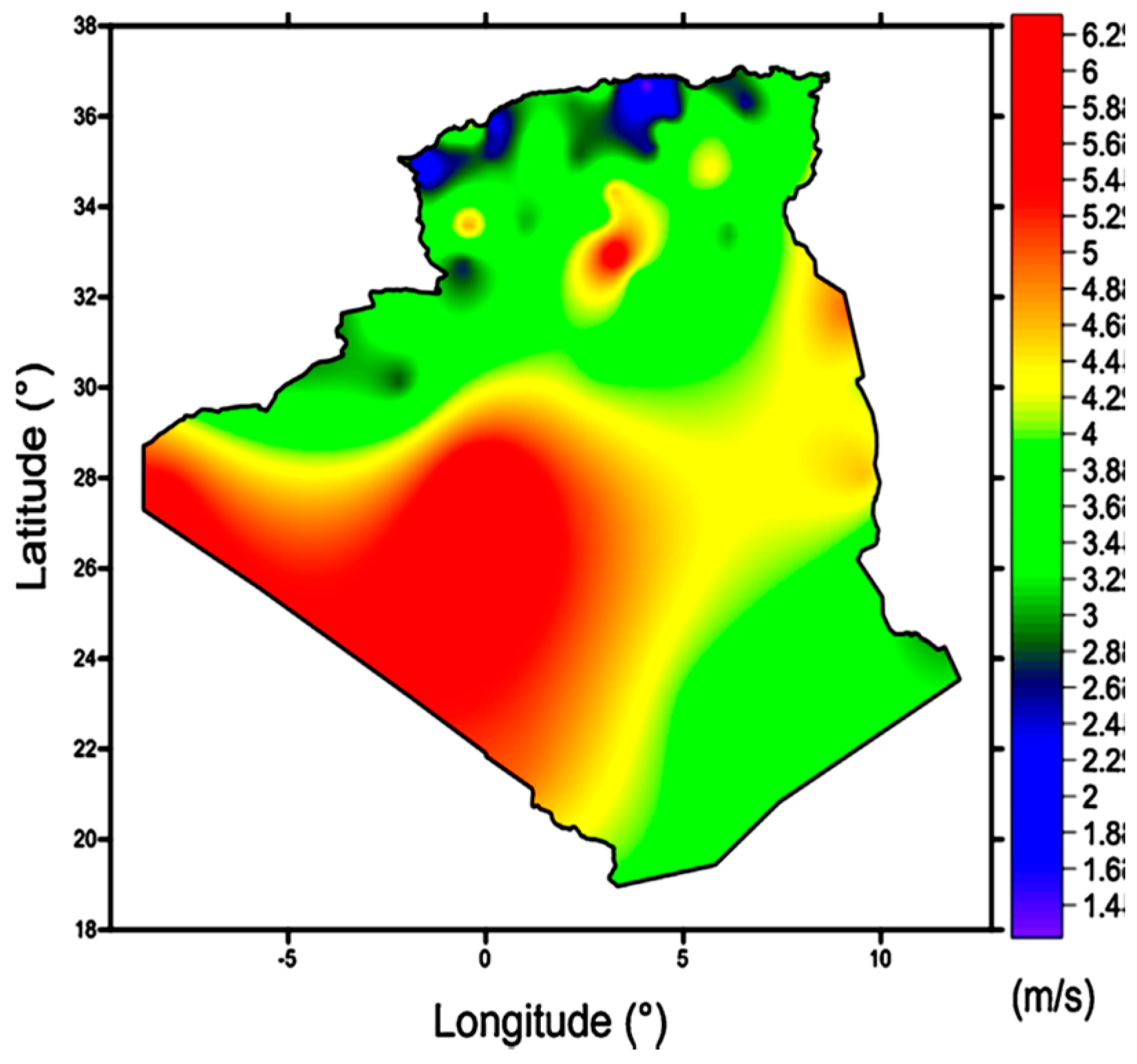

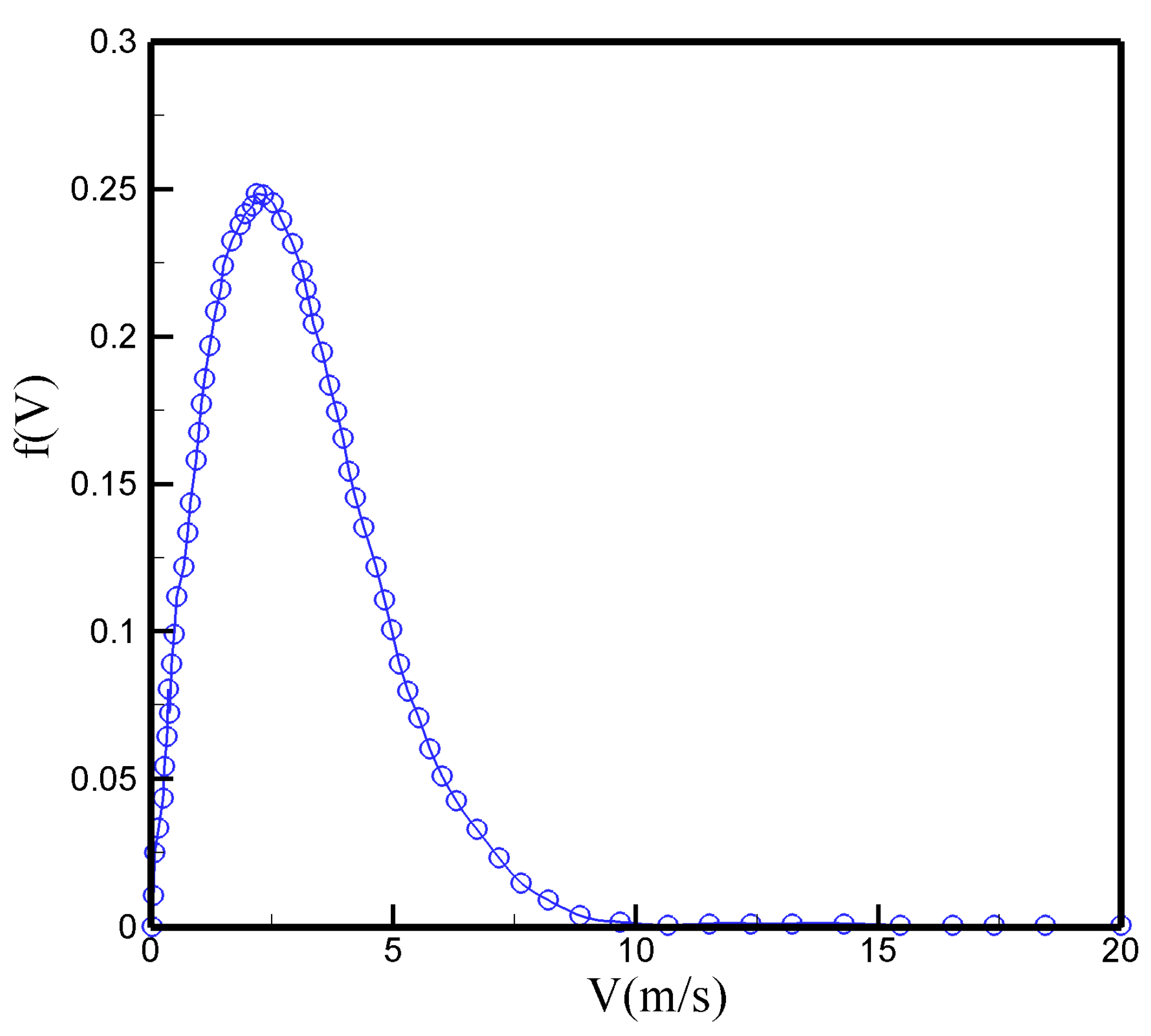



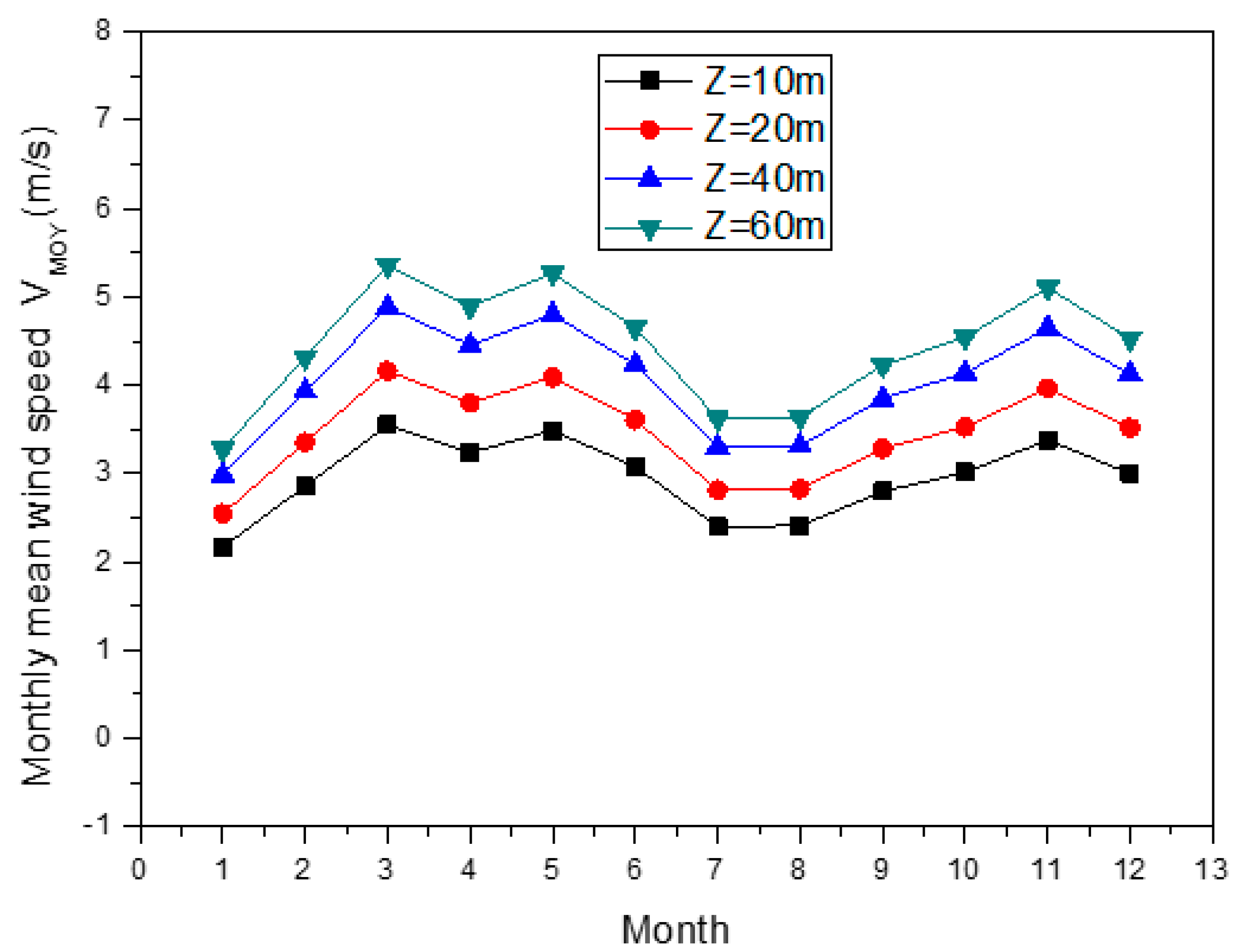
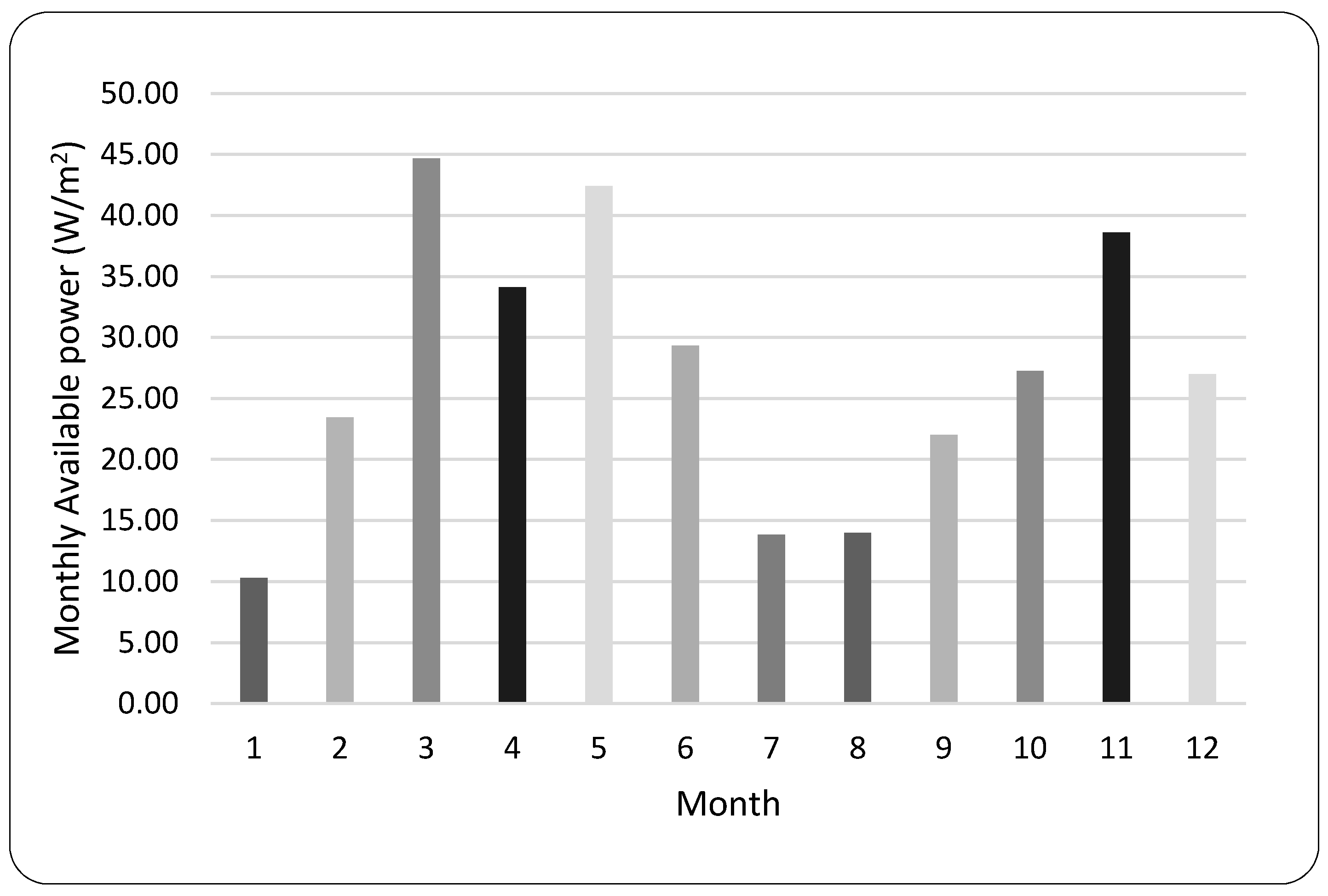

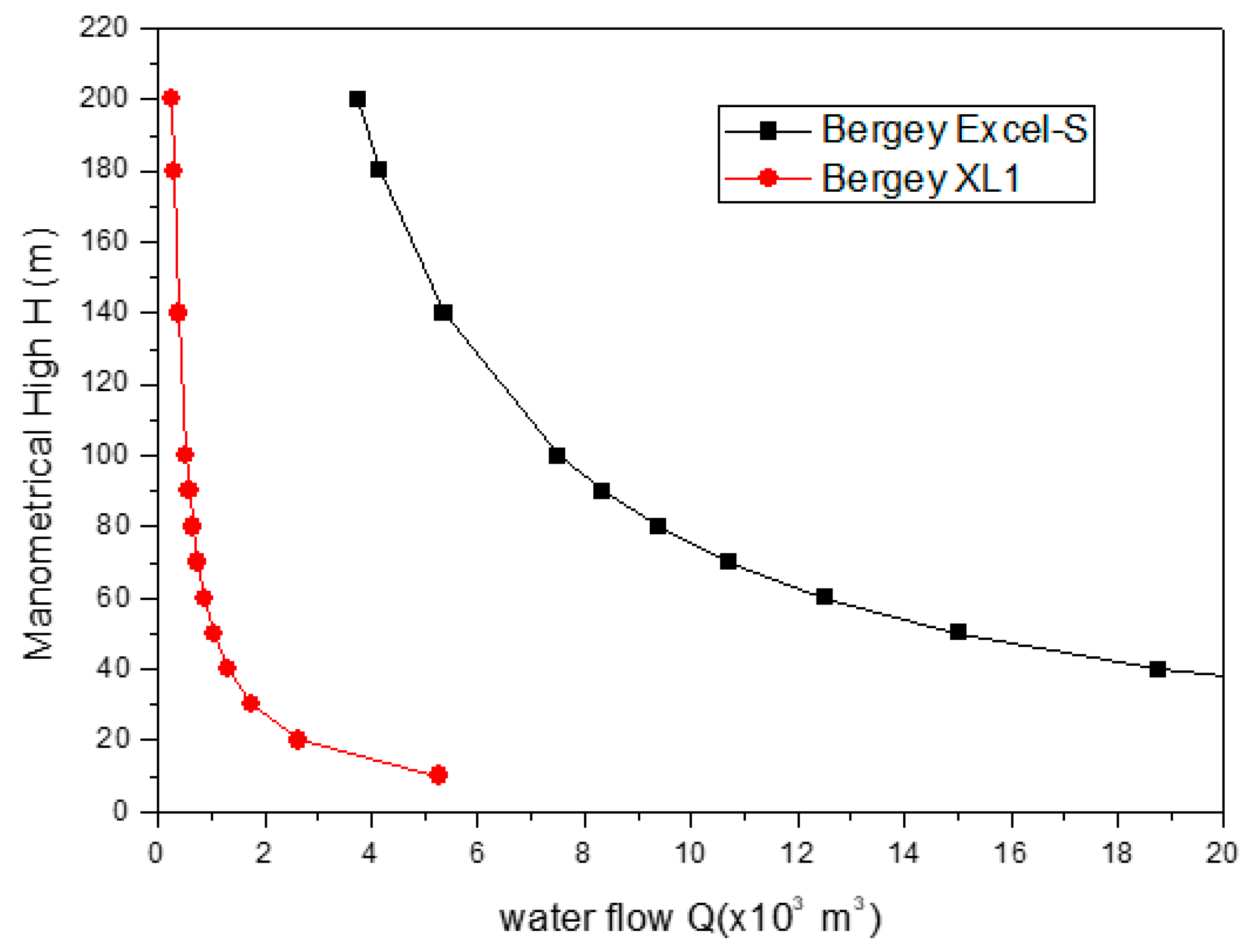
| Investigator (s) | Investigated System | Highlights |
|---|---|---|
| Ahmad et al. [30] | Wind–PV–biomass hybrid renewable energy system. | The results of the techno-economic feasibility study show that hybrid power system can generate more than 50 MW. |
| Yahyaoui et al. [31] | Stand-alone PV–wind system. | The approach’s efficiency is demonstrated throughout the cold, moderate, and hot seasons, using measured climatic data and a Tunisian household power consumptions. |
| Li et al. [32] | Solar–wind–biomass off-grid hybrid power system. | The results show that a hybrid power system comprising solar, wind, and biomass is a reliable and cost-effective option for sustainable remote rural electrification while achieving environmental benefits. |
| Allouhi et al. [33] | Hybrid PV-T/wind system with thermal storage for electricity and heat generation. | Self-consumption and self-sufficiency ratios are 90.25% and 43.08%, respectively. |
| Patwal et al. [34] | Pumped storage hydro-thermal system with wind energy sources (WES). | The impacts of WES is evident from the results of test system-III, which illustrated that WES was able to reduce the total thermal power generation by 4528.85 MW and optimal cost by 19.86%. |
| Jeon et al. [35] | Self-powered electro-coagulation (SPEC) system driven by a wind energy harvesting triboelectric nanogenerator for decentralized water treatment. | The SPEC system removes 90% of algae and 97% of organic dye with self-powered treatment for 72 h. |
| Bos et al. [36] | Wind power to methanol: renewable methanol production using electricity, electrolysis of water, and CO2 air capture. | 10 MW wind turbines can accommodate the air capture instalation in the base tower. |
| Maleki [37] | Autonomous solar–wind-reverse osmosis desalination systems coupling battery and hydrogen energy storage. | The results showed the robustness of the energy management method and proposed algorithm. |
| Station | Latitude (N) | Longitude (E) | Elevation | ||
|---|---|---|---|---|---|
| Deg | Min | Deg | Min | (m) | |
| Batna | 35 | 38 | 4 | 50 | 1036 |
| Guelma | 36 | 28 | 7 | 28 | 290 |
| Medea | 36 | 16 | 2 | 45 | 881 |
| Meliana | 36 | 18 | 2 | 14 | 715 |
| Chlef | 36 | 12 | 1 | 20 | 143 |
| Tiaret | 35 | 23 | 19 | 22 | 995 |
| Tlemcen | 34 | 53 | 19 | 12 | 842 |
| Station | Weibull Parameters | v | Pdisp | Precup | |
|---|---|---|---|---|---|
| k | c (m/s) | (m/s) | (W/m2) | (W/m2) | |
| Batna | 1.61 | 4.91 | 4.40 | 130.92 | 77.24 |
| Guelma | 2.10 | 4.80 | 4.30 | 87.49 | 51.62 |
| Medea | 1.90 | 3.32 | 2.90 | 46.18 | 27.25 |
| Meliana | 2.43 | 5.11 | 4.53 | 72.37 | 42.70 |
| Chlef | 1.95 | 3.37 | 3.31 | 28.20 | 16.64 |
| Tiaret | 1.72 | 6.20 | 5.50 | 233.92 | 138.01 |
| Tlemcen | 2.02 | 4.29 | 3.80 | 64.92 | 38.30 |
| Type | Manufacture | D (m) | vn (m/s) | Pn (kW) | Cut-in Speed (m/s) |
|---|---|---|---|---|---|
| Bergey Excel-S | Bergy Co (Santa Rosa, CA, USA) | 6.7 | 16.0 | 10 | 3 |
| Bergey XL1 | Bergy Co (USA) | 2.5 | 18.0 | 1 | 2.5 |
| Fuhrlander FL | Fuhrlander (Libenscheid, Germany) | 21 | 11.5 | 100 | 3 |
| Enercon E33 | Enercon (Aurich, Germany) | 33.4 | 13.0 | 335 | 3 |
Publisher’s Note: MDPI stays neutral with regard to jurisdictional claims in published maps and institutional affiliations. |
© 2021 by the authors. Licensee MDPI, Basel, Switzerland. This article is an open access article distributed under the terms and conditions of the Creative Commons Attribution (CC BY) license (https://creativecommons.org/licenses/by/4.0/).
Share and Cite
Alliche, M.; Rebhi, R.; Kaid, N.; Menni, Y.; Ameur, H.; Inc, M.; Ahmad, H.; Lorenzini, G.; Aly, A.A.; Elagan, S.K.; et al. Estimation of the Wind Energy Potential in Various North Algerian Regions. Energies 2021, 14, 7564. https://doi.org/10.3390/en14227564
Alliche M, Rebhi R, Kaid N, Menni Y, Ameur H, Inc M, Ahmad H, Lorenzini G, Aly AA, Elagan SK, et al. Estimation of the Wind Energy Potential in Various North Algerian Regions. Energies. 2021; 14(22):7564. https://doi.org/10.3390/en14227564
Chicago/Turabian StyleAlliche, Mounir, Redha Rebhi, Noureddine Kaid, Younes Menni, Houari Ameur, Mustafa Inc, Hijaz Ahmad, Giulio Lorenzini, Ayman A. Aly, Sayed K. Elagan, and et al. 2021. "Estimation of the Wind Energy Potential in Various North Algerian Regions" Energies 14, no. 22: 7564. https://doi.org/10.3390/en14227564
APA StyleAlliche, M., Rebhi, R., Kaid, N., Menni, Y., Ameur, H., Inc, M., Ahmad, H., Lorenzini, G., Aly, A. A., Elagan, S. K., & Felemban, B. F. (2021). Estimation of the Wind Energy Potential in Various North Algerian Regions. Energies, 14(22), 7564. https://doi.org/10.3390/en14227564








